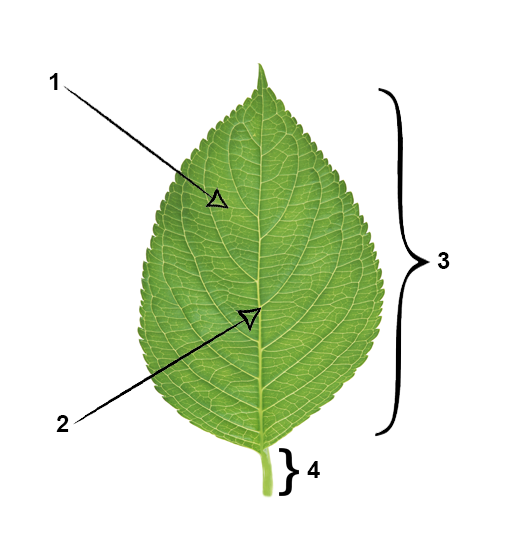What is Morphology?
Study of external form or structure
What is Anatomy?
The Study of Internal Structures
What is Transpiration
Transpiration- loss of water vapor from the stoma/stomata of the leaf
Morphology
Study of External Structures
What is Number 2 Pointing to?
Midrib
What is #1, #2, and #3

#1 - Upper epidermis
#2 - Palisade Mesophyll
#3 - Air Cavity
What is one example of when there is more or less transpiration?
Temperature
When there is higher temperature there is more transpiration
(Many differnt answers)
What is the word formula for Photosynthesis
Anatomy
Study of internal structures
What is #4 pointing to?
petiole
What are the 3 functions of the Waxy Cuticle?
Protects the epidermis and the leaf
It allows the light to pass through it
Prevents loss of water from the surface of the leaf
What is Water Potential
The amount of water
Where does carbon dioxide enter through
Stoma/Stomata
Transpiration and photosynthesis
Transpiration - The loss of water vapor from the stoma/stomata of the leaf
Photosynthesis - The process in which glucose and oxygen are made
What is the Margin?
Edge around the leaf
Why is there no stomata on the upper epidermis?
If there were Stoma on the upper epidermis then since it is facing the sun, all the water vapor released in transpiration would be absorbed
How does transpiration help in the water cycle?
After transpiration, the water vapor goes into the air to form clouds
How does Sunlight enter the plant
Chlorophyll Traps and absorbs it.
Water Potential
Amount of water
What is a compound leaf? Give one example
Leaf is divided into smaller sections called leaflets.
Fern
What is transpiration
loss of water vapor from the stoma/stomata of the leaf
What is Global Warming
When you cut down plants and trees it gets hotter since the amount of moisture in the air is getting reduced. ( plants and trees give out that moisture)
What is the photosynthesis formula
*Both word and number form
Word Form - Water + Carbon Dioxide + Energy from the sun = Glucose + Oxygen
Number Form - 6 H2+ 6 CO2+ENERGY = C6H12O6+O2
Humid and Saturated
Humid - moisture in the air
Saturated - full of water/humidity